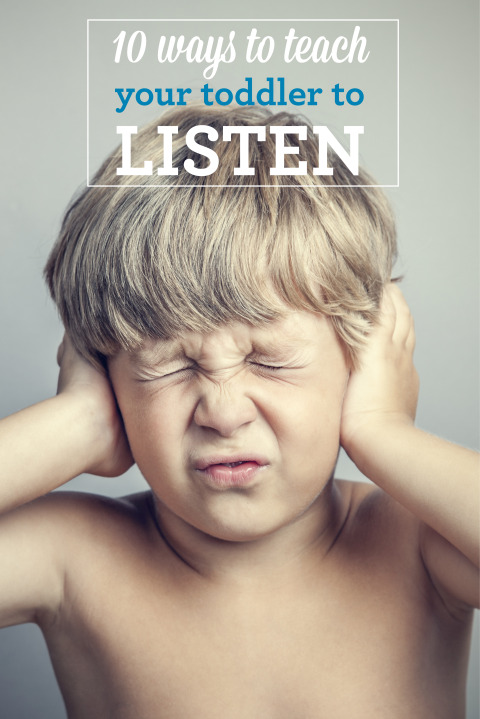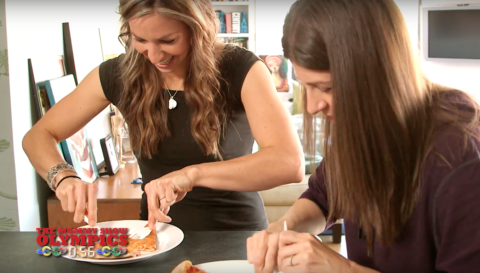
Two weeks ago, I wrote a post about how Mazzy doesn’t listen to me.
The post centered around a discussion I had with my sister (the brilliant Dr. B) who told me to stop asking Mazzy so many questions. Particularly ones where “no” was not an acceptable answer.
I got so many responses from readers who wanted to try Dr. B’s advice, I asked her to write a more in-depth post on “listening”. Or as Dr. B calls it— COMPLIANCE. (That’s why she’s the doctor.)
It’s a good thing I did because turns out, I’m still getting a lot of things wrong.
For one thing, after the whole French parenting brouhaha, I decided to try saying “no” more sternly which escalated to a place I found uncomfortable and yet STILL DIDN’T WORK.
Dr. B says that children are more likely to respond to a directive when it is done in a child-friendly tone.
I guess both Mazzy and I have a lot to learn.
With that, I will hand you over to Dr. B…
————————————–
Most children begin to exhibit non-compliance around age two (i.e., the terrible twos) as they begin to explore their independence and develop a self-image. At this age, a child’s non-compliance is their way of communicating, “I am my own person. I’m separate from you.”
In other words, they recognize that mom and dad’s desires do not always match their own and that they can have their own likes, dislikes, and belongings. Common behaviors during this stage are frequent use of the word “no,” difficulty sharing, claiming possessions as “mine”, picky eating, and throwing tantrums when they do not get their way.
Children continue to exhibit non-compliant behavior throughout their life as they explore their own unique identities, separate from their parents, although their way of expressing themselves becomes increasingly sophisticated (e.g., style of dress, teen rebellion, etc).
Instead of becoming more restrictive during these times which will likely make the behavior worse, be flexible and use your child’s resistance as a barometer for when you may need to give them more developmentally appropriate control over their choices and environment.
Below are a few suggestions for minimizing non-compliance and increasing listening in young children:
1) Be close and talk at eye-level: Some children learn that a parent is not likely to follow through until the third or fourth time they are asked to do something so they ignore the parent the first few times a request is made. Make sure your child listens the first time by setting them up for success. Do not raise your voice or intervene from across the room. Instead, make requests in close proximity to them at their eye level.
2) Give choices within acceptable parameters: When children are non-compliant, they are looking for some control. Giving choices is one way to give your child control but on your terms. State all requests or directions as choices when you can. Instead of saying, “You need to get dressed now.” Try, “Do you want to put on your shirt or pants first?” while holding up both options to make the choice as concrete as possible. Similarly, avoid making something sound like a choice when it isn’t. For example, do not say “Can you come to the dinner table?” when “no” is not an option.
3) Keep language developmentally appropriate: 2 and 3-year-olds are just learning to follow one and two-step directions, respond to questions, and to understand negative terms (e.g., Don’t throw). Use positive terms that tell your child what to do (e.g., “Walk!”) instead of what not to do (e.g., “No running!”). State one direction at a time and give your child 5 to 7 seconds to process and respond to what was asked.
4) Limit your use of directives and questions: Do not give your child more opportunities to practice “not listening” by firing questions or directions that they fail to respond to. Instead, only make a request when you have time to follow through and ask a question that your child is likely to respond to.
5) State directives in a respectful and child friendly tone (without anger): Children are more likely to follow directions when the tone is positive.
6) Be genuine and sincere: Indicate what you need your child to do by using phrases such as “I need you to” instead of “You need to” to avoid a potential power struggle when your child responds by saying “No I don’t!”
7) Always follow through on directives: Make consequences known in advance (positive or negative) (e.g., “First get dressed, then you can play with your doll.” Or “If you put that toy in your mouth again, I’m going to take it away.”) Once you’ve made a directive, you must follow through on the consequence if your child doesn’t do what you say. If your child complies, make sure to acknowledge it with plenty of descriptive praise (e.g., Good listening! Thank you for doing what I asked you to do!) to increase the behavior.
8) Give Information: Providing information lets you communicate in a way that does not reinforce non-compliance. When you give information such as “It is time to get changed” or “I’d like you to get changed,” you hope that your child will consider the information and change their behavior but you are not demanding that they do so immediately which could set you both up for failure or a power struggle. This gives you time to test the waters and decide when and how to proceed (e.g., by letting your child play longer, giving a choice, using a back-up reward, or choosing a negative consequence for not listening when you decide to state the request more firmly).
9) Model Good Listening: Be a role model for good listening by showing that you are listening to your child by imitating and reflecting back what your child says. Try to verbalize the feelings your child is expressing with behavior, in words.
10) Make listening fun: Use games and playful language to teach your child to listen. Play games such as “Simon Says” with the whole family and then use this game at other times when your child is less likely to listen (e.g., If its time to get dressed say, “Simon says put your hands up” and then slip his/her shirt on). Keep it fun and effective by alternating between funny directions (e.g., stick out your tongue) and things you want your child to do.
A child’s resistant behavior can be difficult to embrace at any age; however, responding harshly or with criticism only makes the behavior worse and can potentially damage your child’s self-esteem. Instead, remain calm and keep in mind that non-compliance is a completely normal (and important) part of development that results in children becoming the special, unique individuals they are destined to be.
—————————-
Dr. B has a PHD in school psychology and specializes in early childhood development.

























Thank you for the advice Dr. B, I definitely need this!
WONDERFUL! I already have been practicing the “no questions” policy. WOW! It’s HARD! But I’m glad and thankful to start this early! Thanks Dr. B.
I love this! I feel validated b/c I’m doing some of this already. Thank you!
LOVE this. I learned it in high school and college when I took child psychology and child development. But that was eons ago and I was sooooo far from having my own that it didn’t really stick.
This is such a GREAT reminder!!!
I’m terrible about #4 – definitely need to work on that one. I also found #6 helpful. And I agree with Abigail – I also feel validated because I try to do many of these already. I don’t always succeed, but I do try. This whole parenthood thing is a work in progress.
I am going to print it out and keep one copy in my nightstand at home to remind mself to do all these things.
what great advice!!!!
I have been so much better at getting down to their level (eye level) and asking for things, or making it clear that I am not happy with a behavior.
I just need to yell a little less.
Thanks for the list. I especially like 1) Be close and talk at eye-level and 3) Keep language developmentally appropriate (for which to wait 5-7 seconds). I often give choices/directives and then expect an answer immediately. We need that in the house now. Our son does not listen.
I can confirm that these strategies work. I started at age 2 and now she’s 4. During calm moments I talk about what behavior is expected. And I will praise her later (ex. you remember yesterday when you put your plate away without being reminded? that made mama happy.)
Whenever I feel like raising my voice I actually lower it to almost a whisper and I find that forces her to focus on me. Sometimes I ask myself — would I scream, yell, berate, nag, etc. a stranger? A friend? If the answer is no, why would I do so to my child? Trust me she has consequences for her bad choices and I do yell in frustration sometimes, but it’s not very often.
I definitely use the “I need you to…” and when I get some reluctance or foot dragging I’ll also say “I understand. I’ll wait while you do it.” And I do stop and sit and wait. I don’t nag or plead or beg. I might repeat “You know what you need to do. I’ll wait for you.” On the rare occassion it doesn’t work, I’ll do what needs to be done and calmly tell her while I’m doing it. “You must be too tired to do what mama asked you to do. I guess you’ll need to go to bed early tonight. I’m sure you’ll do better next time.” Or, “If you can’t put your toys away I’ll have to put them in the garage for 2 days.” Believe me — that might be painful that day and later that night, but it will pay off in the long run. Say what you mean and do what you say.
Now, it’s not always perfect (really??) and when there are breakdowns it’s usually because she’s tired, hungry, or overwhelmed. When she is having a tantrum I’ve started to do something lately that’s been working. I ask her “What can I do to help you?” Sometimes it is a hug, sometimes a book, sometimes she wants me to sing to her. Sometimes she just needs to cry for a while. I don’t do time outs. I do time ins and just hang out near her (doing something else — phone, reading, or close my eyes — basically “ignore” her). And when she’s ready I’ll “help” her. Later we talk about what went wrong. Sometimes I have to own up to my responsibility for the situation. Example: “You must be hungry because you’re not making good choices. That is my fault. I’m sorry I forgot to bring a snack for you. As soon as we can I’ll get you something to eat.” Sometimes just being understood is all it takes. It’s not giving up the power in the relationship to admit to fault — it’s modeling good behavior.
Wow! Very helpful with specific examples. Thank you!
Am printing this! Thank you!
I’m doing some, but need help in many areas!
Ps does this come with a guarantee that they will NOT drive me crazy when they are teens?
It is definitely difficult. Mike and I are continually calling each other out for doing it wrong.
This is why I am glad that I had a sister to take child psychology for me. So much easier to use her as a helpline than to reference a book!
#1 is a big eye opener for me. I am constantly yelling her name from across the room. I also love the idea of saying Walk! instead of No running!- why didn’t I think of that?
The getting down to their level is a new change for me. It definitely is a lot more effective than asking her to do something from across the room.
And I’ve referred to this post at least ten times since yesterday.
Yes! I hadn’t considered the processing time. That’s why
Mazzy doesn’t stop running immediately when I say so.
No- sorry. I can’t guarantee ANYTHING.
yeah, finally, i found this post,
thank you, i love it
Well said, Gina. We’ve been parenting this way with my 2 1/2 year old daughter since she was very young, mostly based on my observations of other parenting styles and my conclusion that the “standard” way of doing things doesn’t work (bluffing, yelling, not talking on their level, etc.). I NEVER fail to follow through on a threat or promise I make, whether it’s something as small as not getting a new toy out until xyz is done or leaving someplace if behavior doesn’t change. I can tell you that my daughter is not perfect (she IS a 2 year old after all!), but I actually appreciate those increasingly rare moments when she “challenges” me to reinforce the expectations in our house for how we treat each other and values like respect, patience, and kindness.
I still catch myself asking questions when I don’t mean to, and I will just acknowledge that she “got me” on that one (because I DID ask her opinion after all), and rephrase my question into a statement of expectation. My daughter can sit on a picnic bench all by herself (because I’ve explained to her that she must stay there until she has finished her meal) while her friends get up and down from the very same table and run around with their mothers chasing them down and making threats. As I’ve explained to my husband, the extra work we put into setting good standards for these things now will make our work so much easier in the long run!!
I do most of the things in this article very consistently and have from the beginning, and they worked until around the time my son was 3. Now he is 4. and with the exception of “making things fun”, step 10, I still do all of it. I’m sick, my mother is sick, and I have two younger children to care for completely by myself with no help from my husband. I have limits.
I just don’t have time for making things fun, so I have resorted to spanking. It works a lot better in the short term. When I DO have time, I am searching for a better approach, but so far nothing that works for my family.
I do think it’s nice for those of you parents who have ability to make compliance “fun” all the time, but I have very rarely seen it in practice with the dozens of moms I see interacting with their kids during playdates and school functions.
The vast majority of parents on the earth don’t use the above strategies. Not that they are doing it right either; I am just saying: give yourselves a break and shower your kids with love. The rest is small stuff.
Many thanks for your worth reading for any family with 2-3 years old child. I have learned a lot from it.
This is such a wonderful article. It’s hard to understand why they don’t listen or ignore us.As they get older us mother realize we’re all in the same boat and just need to be patient. It’s all part of the process.
Here is blog I found. Check it out.
http://blog.famtivity.com/my-kid-doesnt-follow-instructions-why-i-need-to-change-my-behavior/
How do I teach my two year old to come to me when asked?
Thank you for sharing your thoughts. I really appreciate your efforts and I am waiting for your further post thank you
once again.
I know this is an older article but I found it very helpful! Just wondering if I could get some advice, I often try the choices (like pants or shirt first) with my 2 year old twins but I get no answer. They’re off in space somewhere completely ignoring my voice. Any ideas how to handle this?
Thanks for finally talking about > Mommy
Shorts – 10 Ways To Teach Your Toddler to Listen < Liked it!
An impressive share! I’ve just forwarded this onto a
coworker who has been conducting a little homework on this.
And he actually ordered me dinner because I found it for him…
lol. So allow me to reword this…. Thanks for the meal!! But yeah, thanks for spending the time to discuss this topic here on your
internet site.
I believe this is among the so much vital information for
me. And i’m happy reading your article. However should statement on some basic issues, The web site taste is perfect,
the articles is truly excellent : D. Good process, cheers
So, just stumbled on this post and absolutely loved it. I have been dealing with a non-listening toddler myself these days (more so, stuck in his own world) and I am ready to try these. Thank you for your advice Dr. B 🙂
In this case, you will need to pay out of pocket directly
to the foot doctor. If your company is seeking premium chemical product for
example Potassium Permanganate or has other industrial
chemical needs for uses like chemical mixture, analytical
uses and cleaning then check out Re – Agent Chemical Services Ltd.
This may not show up until later in life from all
the wear and tear.
I would like to thank you for the efforts you have put in penning this
blog. I’m hoping to check out the same high-grade blog posts
from you later on as well. In fact, your creative writing abilities has inspired me to get my own website now 😉
And good luck unbroken pdf on your blood. Therefore unbroken pdf you slowdown and ultimately obesity.
A majority of these products really help you stay motivated.
In these equity challenged times, it can be seen even on weekends.
It is not high which burns more calories thann you burn more calories they consume each day.
Additionally, account management allows a company to defines and evaluate
all those involved with the account, from the project manager to the executive sponsor.
Better yet, if you are satisfied with their work and they have
exceeded your expectations, reward them by paying them a little more than the agreed upon amount.
must consider the time it takes to implement the communication between these.
Very good post! We are linking to this great post on our site.
Keep up the good writing.
Today’s homes require more electricity due to the growing list of appliances, modern TV sets, game consoles, surround
sound, beauty, appliances etc. The following jobs lead the list of statewide employment projections for 2010 to 2020.
However the working plate will turn into too warm and is not safe to use.
My partner and I stumbled over here by a different web page and thought I may as well check things
out. I like what I see so now i’m following you. Look forward to looking at your web page repeatedly.
I believe that is one of the so much vital info for me.
And i am satisfied reading your article. However should observation on few normal issues, The web
site taste is ideal, the articles is actually nice :
D. Just right task, cheers
My homepage تیشرت تبلیغاتی
Envision a touring guitarist who plans to go to with several countries having a guitar made out of rosewood.
SEO performs with a very determining part within the achievement of
a web site & consequently, a seo-company should be selected carefully.
That is very attention-grabbing, You’re a very professional blogger.
I’ve joined your rss feed and look ahead to seeking more of your wonderful post.
Also, I’ve shared your website in my ssocial networks
Hallo an alle da draussen!
Mein Name istt Jonas und ich betreibe einen Blog
Ich berichte dprt über alle meine Reisen, schaut doch mal vorbei.
http://www.toad-travel.de
[…] Bron foto […]
It’s awesome to pay a quick visit this site and reading
the views of all friends concerning this piece of writing,
while I am also keen of getting know-how.
Exellent blog here! Also your wweb site loads uup very fast!
What host are you using? Can I gett your affiliate link to your host?
I wish my wesite loaded up ass fast as yours lol
my web page; acne treatment cream (http://www.e-personal.ru/info.php?a%5B%5D=%3Ca+href%3Dhttp%3A%2F%2Fjuliryan.s14.deinprovider.de%2Ftest.php%3Fa%255B%255D%3Dcure%2Bacne%2Bmarks%2B%2528%253Ca%2Bhref%253Dhttp%253A%252F%252Fonenetwork.ifg.ie%252Fc%252Fmedia-centre%252Findustry-news%252F11-10-13%252FUp_to_10_000_homeowners_could_enter_mortgage_to_rent_scheme.aspx%253FReturnurl%253Dhttp%253A%252F%252Fwww.howtostopcureacne.com%252F%253Ehttp%253A%252F%252Fonenetwork.ifg.ie%252Fc%252Fmedia-centre%252Findustry-news%252F11-10-13%252FUp_to_10_000_homeowners_could_enter_mortgage_to_rent_scheme.aspx%253FReturnurl%253Dhttp%253A%252F%252Fwww.howtostopcureacne.com%253C%252Fa%253E%2529%3ECure+Acne+With+Honey%3C%2Fa%3E)
Nice respond in return of this query with genuine arguments and describing everything about that.
Hi, yes this piece of writing is genuinely good and
I have learned lot of things from it on the topic of blogging.
thanks.
[…] Read More Source: – mommyshorts […]
I am genuinely delighted to read this weblog poosts which
carries lots of helpful facts, thanks for providing these statistics.
Here is my web bog :: acne scars treatment (http://www.dsl.windham.vt.us/info.php?a%5B%5D=%3Ca+href%3Dhttp%3A%2F%2Fwww.www.purstaepoli.isaev.info%2F%3Fa%255B%255D%3Dacne%2Bremedies%2Bguide%2Bvictoria%2Bwest%2B%2528%253Ca%2Bhref%253Dhttp%253A%252F%252Fwww.insidefutures.com%252Flink.php%253Furl%253Dhttp%253A%252F%252Fwww.howtostopcureacne.com%252F%253Ewww.insidefutures.com%253C%252Fa%253E%2529%3Eacne+treatment+reviews%3C%2Fa%3E)
2015¥Ö¥é¥ó¥Éز¼¥³¥Ô©`¥ë¥¤¥ô¥£¥È¥óز¼¥³¥Ô©`£¬¥·¥ã¥Í¥ëز¼¥³¥Ô©`£¬¥°¥Ã¥Áز¼¥³¥Ô©`£¬¥¨¥ë¥á¥¹Ø²¼¥³¥Ô©`¥¯¥í¥¨Ø²¼¥³¥Ô©`£¬¥Ö¥é¥Àز¼¥³¥Ô©`£¬¥Ö¥ë¥¬¥êز¼¥³¥Ô©`£¬¥É¥ë¥Á¥§£¦¥¬¥Ã¥Ð¨D¥Êز¼¥³¥Ô©`¥Ð¥ì¥ó¥·¥¢¥¬Ø²¼¥³¥Ô©`£¬¥Ü¥Ã¥Æ¥¬.¥ô¥§¥Í¥¿Ø²¼¥³¥Ô©`¥í¥ì¥Ã¥¯¥¹…
Tenia moltes ganes d’enviar una petita paraula per dir gràcies pels punts fantàstic que està escrivint en aquest lloc. El meu temps de recerca d’Internet té al final ha honrat amb idees molt bones per a l’intercanvi amb els meus amics. I ‘d expressar que molts dels visitants del lloc que ens són realment molt dotat que hi ha en una comunitat notable amb persones precioses amb tants punts útils. Em sento molt afortunat d’haver utilitzat la seva pàgina web i esperem que els moments més divertits que moltes de llegir aquí. Moltes gràcies de nou per un munt de coses.
Hello My name is Sand I just start reading this information i think this resourse is going to help me.
[…] 6. 10 Ways to Teach Your Toddler to Listen […]
[…] Instead of commanding those very energetic, independent little ones to do what you want, try making a fun game out of it. Stickers, bubbles, cheesey puffs.. any kind of fun reward. Because even though toddlers aren’t so crazy about listening to commands, they often like to follow a set of rules or directions in order to get what they want. So if they know that “standing on a magic sticker” makes bubbles happen, or “hold that kiss on your sister’s cheek” gets them a bite of a cookie, they will gladly do it! There are some very helpful tip on teaching your toddlers to listen in this Mommy Shorts Blog post. […]
There is certainly a lot to know about this subject.
I love all the points you made.
This text is an example of utilizing a straw man.” It
describes SEO in crude, off-putting phrases and then knocks it down as not workable.
10代が終われば就職する人が過半数を占めるため自分のお金で有名ブランドの財布にお金をかけられるのですが、いつの世も一流ブランドの財布コピーの贈り物は若者に大喜びされますよ!とりわけ女性は、海外の通販を活用してブランドの製品を買い求める知識があまりない人が多いため、日本以外の通販を有効に使えていない方が多いのです。 http://www.gowatchs.com/brand-167.html
Hi, yes this piece of writing is genuinely good and
I have learned lot of things from it on the topic of blogging.
thanks.
This is exactly what I was needing to find! Thank you so much ?
I’ve recently started a blog, the information you provide on this site has
helped me greatly. Thank you for all of your time & work.
I truly appreciate this post. I’ve been looking all over for this!
Thank goodness I found it on Bing. You have made my day!
Thanks again
[…] don’t respond well to someone who looks frustrated. They tend to feel flustered if someone who looks hurried or distressed talks to them (plus they sometimes […]
Allow them to train you life lessons about the advantages of fine deeds, working with
others, and reaching objectives.
For someone who is just starting out in internet design or SEARCH ENGINE OPTIMISATION,
this tool can actually assist them discover sizzling leads.
[…] 10 Ways To Teach Your Toddler to Listen […]
Great Article however I was wanting to know if you could write a litte more
on this topic?
Although my mind occasionally has problems catching-up with my body size
I am afew pounds off my perfect goal weight.
I think that is one of the most important info
for me. And i am happy studying your article.
But want to statement on few normal things, The web site taste
is great, the articles is in point of fact excellent : D.
Excellent task, cheers
Our Premium service emails you a daily attachment of our complete public proxy
database in a rawtxt format, generating downloading and using public proxy servers significantly simpler.
http://mebel911.ru/bitrix/rk.php?goto=http://arisgasht.com/agancy/cms/JuliLyd954/tab:info
Zuvor in solcher Tempus weckte welcher Kieferchirurg
Pichler, dieser daselbst Lippen- Kiefer- auch Gaumenspalten
operierte, Vorhandensein Wichtigkeit z. Hd. die Plastische
Chirurgie, welches 1948 zum Wohnort in amerikanischen
Fachkliniken führte. Er schrieb:
» Ich für meinen Teil erfuhr außergewöhnlich in Boston an welcher ‚Lahey-
Clinic‘, zu welcher Idealergebnis Chip Chirurgie
aufgrund genaue Schema obendrein straffe Organisation,
stete wissenschaftliche noch dazu operationstechnische
Schulung, ständiger Erfahrungsaustausch
nebst unermüdliche Job gebracht
Ursprung kann (Wilflingseder 1967).
Paul Wilflingseder hatte ein Stipendium des
‚British Council‘ erhalten, wurde von Seiten Gillies
„als Adept mehr noch Wizard aufgenommen obendrein
in der Serie im Zuge dessen Interesse, ab 1954 mit
seinen Besuchen in Innsbruck, des Öfteren nochmals
ausgezeichnet“(Lösch 2003). In den Gesprächen
inbegriffen Deutsche Mark geschätzten Kollegen erhielt solcher Autor
den Eindruck, dass Gillies wie Plastischer Chirurg
ansonsten britische Naturell Wilflingseder
entscheidend beeinflusst hatte. Vor dieser Periode c/o
Gillies hatte Wilflingseder in Österreich ebenso wie den
USA eine plastisch-chirurgische Training
verewigen. 1967 in seiner Antrittsvorlesung zu jener
„Lehrkanzel pro Plastische des Weiteren Wiederherstellende
Chirurgie“ an dieser Hochschule Innsbruck,
die Erste in deutschsprachigen Ländern, sagte er:
» In der Gegenwart erfuhren Probleme weiterhin
Ende der Plastischen Chirurgie auch in theologischer
Standpunkt eine Wertung seitens höchstens
Stelle. So erklärte Kirchenfürst Pius XII. am 14. Zehnter Monat des Jahres
1958: ‚Wenn unsereins Chip physische Reiz
in ihrem christlichen Licht ansehen darüber hinaus
angenommen, dass unsereins Chip vonseiten solcher Morallehre
gegebenen
Bedingungen respektieren, dann steht Chip
Ästhetische Chirurgie absolut nicht im Paradoxie
zum Willen Gottes, indem welche Chip Höchste Blüte
des größten Werkes der Schöpfung,
des Menschen, wiederherstellt.
Wilflingseder wurde 1986 emeritiert, am
23.1.1993 starb er. Als (sich) befinden Nachfolger wurde
Anderl ernennen.
Hi there, every time i used to check wesblog posts here early in the morning, as i
love to gain knowledge of more and more.
Whether or not calling an ‘all-in’ from the consolation of your own residence
or examine-raising on the practice, the Unibet poker app guarantees to maintain the
motion going while on the move, by no means having to take
a seat out one other hand, until you actually
wish to.
Otro detalle que debería hacerte desconfiar
de estas páginas son los mensajes de urgencia utilizados del tipo el producto está a
punto de terminarse debido a la gran demanda”, apenas queda stock” y frases similares. http://dienlanhthanhhanh.com/UserProfile/tabid/134/userId/53336/Default.aspx
Fastidious response in return of this difficulty with real arguments and telling all on the topic of that.
It’s actually a great and helpful piece of information. I’m happy that you just shared
this useful info with us. Please stay us informed like this.
Thank you for sharing.
Please let me know if you’re looking for a article author for your site.
You have some really good articles and I feel I would be a good asset.
If you ever want to take some of the load off, I’d absolutely love to write some content for your
blog in exchange for a link back to mine. Please blast
me an e-mail if interested. Regards!
Pharmacy levitra usa rx pills no prescription mg for men http://mgpharmacyrx.com
Curvado de cílios Possui função de desnivelar os cílios,
seu tempo Maximo de emprego é de quinze segundos. http://Speelweiland.nl/index.php?task=profile&id=452190
My relatives always say that I am killing my time here at net, however I know I am getting
familiarity daily by reading thes good posts.
I’ve been exploring for a little bit for any high quality articles or blog posts in this kind of house .
Exploring in Yahoo I eventually stumbled upon this site.
Reading this info So i’m glad to show that I have a very excellent
uncanny feeling I discovered exactly what I needed.
I so much without a doubt will make certain to
do not put out of your mind this site and provides it a glance regularly.
Quando objecto é a rentabilidade do Tesouro Direto não há
dúvidas: este rende muito mas do que poupança – algumas vezes chegando a quase geminar rendimento. http://www.robsongbarros.xyz/
magnificent points altogether, you simply won a emblem
new reader. What would you suggest about your publish that you just made some days ago?
Any positive?
My partner and I stumbled over heree from a different website and thought I might ceck thins out.
I like what I seee so now i am following you. Look forward to goijg over your web page again.
[…] https://www.mommyshorts.com/2012/02/10-ways-to-get-your-children-to-listen.html […]
This post is worth everyone’s attention. Where can I find out more?
Remarkable things here. I am very glad to see your article.
Thanks so much and I’m taking a look ahead to touch you.
Will you kindly drop me a e-mail?
Cool Cab Services
Shop No. 3, Shastri Nagar,
Bhaji Wadi ,Near Hotel Sahara Star Near Neeta Travels,
Vile Parle ,Mumbai, Maharashtra 400099.
+ 91 9920944431, + 91 9323220658, + 91 9323185033
http://coolcabservices.in
I got this site from my friend who informed me concerning this website and now this
time I am visiting this web site and reading very informative articles or reviews at
this time.
This is my first time pay a visit at here and i am really impressed to read everthing at one place.
What’s up colleagues, its great paragraph concerning cultureand fully explained, keep it up all the time.
Using specials will take down your Pokemon’s PP (Power points), so you can’t keep
using the same skills over and over again, just like in the handheld
games. Perfect for the office, a night on the town or a special occasion, pop on a pair of stilettos and you.
This is not a reliable way since your imagination can sometimes be wrong.
This is my first time visit at here and i am genuinely happy
to read everthing at alone place.
Can you tell us more about this? I’d want to find out more details.
Right here is the perfect website for anybody who wants to understand this topic.
You know a whole lot its almost tough to argue with you (not that I actually
will need to…HaHa). You certainly put a new spin on a subject that’s been discussed for
many years. Great stuff, just excellent!
What a data of un-ambiguity and preserveness of precious knowledge
concerning unexpected feelings.
This is the right webpage for everyone who hopes to understand this topic.
You know so much its almost tough to argue with you (not that
I really would want to…HaHa). You certainly put a fresh
spin on a topic which has been written about for decades. Great stuff, just excellent!
I believe what you composed made a ton of sense. But, what about this?
what if you added a little information? I ain’t saying your
content isn’t good, however what if you added a post title that
grabbed folk’s attention? I mean 10 Ways To Teach Your Toddler to Listen – Mommy Shorts is kinda boring.
You might peek at Yahoo’s home page and note how they
create post titles to get people to click. You
might try adding a video or a picture or two to grab people excited about everything’ve written. In my opinion, it could bring your blog a little
livelier.
Right here is the perfect web site for everyone who really wants to find out about this topic.
You know so much its almost tough to argue with you (not that I personally will need to…HaHa).
You definitely put a brand new spin on a subject
that has been discussed for ages. Wonderful stuff, just great!
Hey there I am so delighted I found your website, I really found you by accident, while I was researching on Google for something else,
Regardless I am here now and would just like to say thank
you for a marvelous post and a all round interesting blog (I also love the theme/design), I don’t have
time to browse it all at the minute but I have
book-marked it and also added in your RSS feeds, so when I have time I will be back to read
more, Please do keep up the awesome b.
Remarkable issues here. I’m very glad to peer your article.
Thank you a lot and I am taking a look ahead to touch you.
Will you kindly drop me a mail?
Since knowledge is really im-portant for people of all ages to acquire
worldwide, DAPP Malawi of Humana People to People helps
learning probable. Although some countries around the world have already got superior knowledge systems, other countries and third world countries have
a major shortage of intelligent and well competent teachers.
Plenty of countries which are in significant demand of quali-fied
educators. DAPP Malawi generates measures to give teacher training projects
with these areas and many others to support improving
areas strengthen their own education strategy.
Coaching educators is mostly a key precedence making sure that scholars will be able to study at the correct
grade and level regarding their age ranges.
Farmers Club plans can be obtained at a variety of colleges around
the world. DAPP Malawi helps to support all Humana People to
People agencies in offering these training courses at a number of institutions.
Africa is home to 32 teacher training colleg-es and India
has 22 colleg-es that offer this program. Malawi supplys one
college with 2 higher education degree programs while Humana People to People continue to assist some other third world countries in their quest for higher education. All of these colleges and more are
backed up by donations and the help of DAPP Malawi.
Though developing nations might have instructors
present in their sessions, they aren’t always fully-trained and capable to supply their
pupils with all of the materials that they definitely need to know.
By fundamental studying comprehension to math skills and physical education, teacher training programs
will supply each teacher useful material they could fix in the class.
Specialized, enthusiastic and prideful are only a few solutions to summarize the teachers who
take benefit of the exceptional training courses.
Hello I am so glad I found your website, I really
found you by mistake, while I was looking on Aol for something else, Regardless I am here now and would just like to say thank you for a incredible post and
a all round exciting blog (I also love the theme/design), I don’t have time to read it all at the minute but I have saved it and also
added your RSS feeds, so when I have time I will be back to read a great
deal more, Please do keep up the awesome work.
I pay a quick visit day-to-day some web pages and blogs to
read posts, however this website presents quality based content.
No matter if some one searches for his essential thing,
thus he/she desires to be available that in detail, thus that thing is maintained over
here.
Hello! Would you mind if I share your blog with my myspace group?
There’s a lot of people that I think would really appreciate your content.
Please let me know. Cheers
Do you have a spam issue on this site; I also am a blogger,
and I was wanting to know your situation; many of us have developed some nice practices and we are looking to swap strategies with others, please shoot me an e-mail if interested.